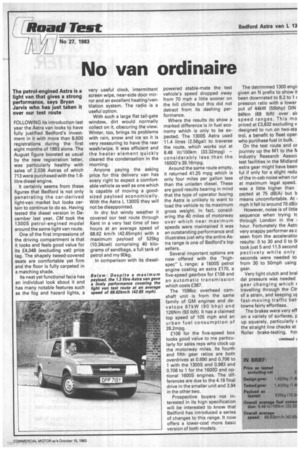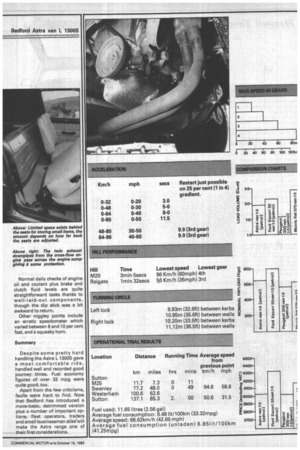No van ordinaire
Page 27

Page 28

Page 29

If you've noticed an error in this article please click here to report it so we can fix it.
The petrol-engined Astra is a light van that gives a strong performance, says Bryan Jarvis who has just taken it over our test route FOLLOWING its introduction last year the Astra van looks to have fully justified Bedford's investment in it with more than 8,600 registrations during the first eight months of 1983 alone. The August figure boosted as usual by the new registration letter, was particularly healthy with sales of 2,036 Astras of which 713 were purchased with the 1.6litre diesel engine.
It certainly seems from these figures that Bedford is not only penetrating the car-derived light-van market but looks certain to continue to do so. Having tested the diesel version in December last year, CM took the 1300S petrol-engined model around the same light van route.
One of the first impressions of the driving compartment is that it looks and feels good value for its £4,048 (excluding vat) price tag. The shapely tweed-covered seats are comfortable yet firm and the floor is fully carpeted in a matching shade.
Its neat yet functional facia has an individual look about it and has many notable features such as the fog and hazard lights, a very useful clock, intermittent screen wipe, near-side door mirror and an excellent heating/ventilation system. The radio is a useful option.
With such a large flat tail-gate window, dirt would normally collect on it, obscuring the view. Winter, too, brings its problems with rain, snow and ice so it is very reassuring to have the rear wash/wipe. It was efficient and the heater element quickly cleared the condensation in the morning.
Anyone paying the asking price for this delivery van has every right to expect a comfortable vehicle as well as one which is capable of moving a goodsized payload economically. With the Astra L 1300S they will not be disappointed.
In dry but windy weather it covered our test route through Kent in a very fast time of two hours at an average speed of 68.62 km/h (42.65mph) with a maximum payload of 525kg (10,34cwt) comprising 40 kilograms of sandbags, a full tank of petrol and my 80kg.
In comparison with its diesel
powered stable-mate the test vehicle's speed dropped away from 70 mph a little sooner on the hill climbs but this did not detract from its dashing performance.
Where the results do show a marked difference is in fuel economy which is only to be expected. The 1300S Astra used 11.4 litres (2.56ga1) to traverse the route, which works out at 8.48 lit/100km (33.32mpg) — considerably less than the 1600Ds 39.16mpg.
Around the same route empty, it returned 41.25 mpg which is only four miles per gallon less than the unladen diesel. These are good results bearing in mind that the type of operator buying the Astra is unlikely to want to load the vehicle to its maximum gross weight. In fact, considering the 40 miles of motorway over which near maximum speeds were maintained it was an outstanding performance and illustrates just why the entire Astra range is one of Bedford's top sellers.
Several important options are now offered with the "highspec" L range; a 1600S petrol engine costing an extra £170, a five-speed gearbox for £106 and an automatic transmission which costs £387.
The 1598cc overhead camshaft unit is from the same family of GM engines and develops 67kW (90 bhp) and 126N m (93 lbft). It has a claimed top speed of 105 mph and an urban fuel consumption of 28.2mpg.
£106 for the five-speed box looks good value to me particularly for sales reps who clock up the motorway miles. Its fourth and fifth gear ratios are both overdrives at 0.890 and 0.706 to 1 with the 1300S and 0.983 and 0.708 to 1 for the 1600D and optional 1600S engines. The differences are due to the 4.18 final drive in the smaller unit and 3.94 in the other two.
Prospective buyers not interested in its high specification will be interested to know that Bedford has introduced a series of changes to this range. It now offers a lower-cost more basic version of both models. The detrimmed 1300 engii given an N prefix to show it been downrated to 8.2 to 1 c pression ratio with a lower put of 44kW (59bhp) DIN 94Nm (69 Hoff) over sir speed ranges. This mo priced at £3,832 excluding v designed to run on two-sta trol, a benefit to fleet oper who purchase fuel in bulk.
On the test route and or journey up the M1 to the N Industry Research Associ, test facilities in the Midland extra gear might have been ful if only for a slight redu of the in-cab noise when rur at maximum legal speed. was a little higher than pected at 75 dB(A) but b means uncomfortable. At mph it fell to around 70 dB0 However, noise is of little sequence when trying tc through London in the hour. Fortunately the Astri very snappy performer as c seen from the acceleratior results: 0 to 30 and 0 to 51 took just 5 and 11.5 second pectively while only seconds were needed to from 30 to 50mph using gear.
Very light clutch and bral dal pressure was needed gear changing which r travelling through the Cit, of a strain, and keeping ur fast-moving traffic bet' towns fairly effortless.
The brakes were very eft on a variety of surfaces, p up squarely, particularly c the straight line checks at Roller brake-testing, ho% ad a slight drop in braking ire on the left-hand front ar brakes, but this was not ast apparent and, as the s suggest the system was p to standard.
dford has decided to alise shoe and drum sizes ss the Astra range to m (9.1in) diameter; brake thickness is increased to [m (0.5in); and brake lining dill be 553sqcm (85.7sqin). d surfaces in and around )n are not all they should t they are not nearly as bad me of the stretches beWesterham and Redhill ! the new link road to the being built.
ts credit, the Astra coped yell, Laden and empty, the characteristics hardly changed at all and apart from a slight tendency towards oversteer coming out of sharp bends, particularly on downwards slopes, the light but positive steering gave a good feel of the road and held its line well. The ride was firm without any unpleasant pitching or rolling.
Manoeuvring between rows of parked vehicles was no hardship either, as the full load tended to ease the weight from the front slightly thus lightening the steering.
Few vehicles will give an even ride unless the driver makes the effort to distribute his load carefully, and unfortunately this type of vehicle body encourages idle drivers. Because of the fairly low — 1.32m (52in) — height of the tailgate roof and the almost knee-high load platform, it can become instinctive for tall drivers to develop an aversion for loading up to the front of the body.
Sliding in heavy boxes and the like is no real hardship as the body floor is ribbed to reduce friction. The sides are lined up to the waist line and secured by wooden battens to prevent panel damage. This also acts as a form of noise insulator.
When loading in the dark there is no assistance from the taillights as they are tucked away from the tail-gate edge. There is, however, a most useful courtesy light in the roof at the back. An unfortunate driver having to change a flat tyre should be able to see to move the load and raise the cover to get at the spare wheel.
A full-width metal bulkhead fitted across the front of the body gives considerable protection to the driver by preventing loads from shifting during sharp braking. The partition has a very useful strip of mild steel channeling attached near the top edge, which is ideal for fitting a mesh grill or equipment securing brackets. Normal daily checks of engine oil and coolant plus brake and clutch fluid levels are quite straightforward tasks thanks to well-laid-out components, though the dip stick was a bit awkward to return.
Other niggley points include an erratic speedometer which varied between 8 and 10 per cent fast, and a squeaky horn. Summary Despite some pretty hard handling the Astra L 13008 gave a most comfortable ride, handled well and recorded good journey times, Fuel economy figures of over 33 mpg were quite good, too.
Apart from the few criticisms, faults were hard to find. Now that Bedford has introduced a more-basic, detrimmed version plus a number of important options, fleet operators, traders and small businessmen alikeywill make the Astra range one of their first considerations.






















































































































